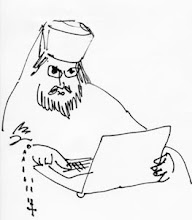It's too easily forgotten that much of the argument surrounding the new edition of the OSB played out fifteen years ago. Here's how Archimandrite Ephrem (Lash) began his review of the 1993 edition of the OSB:
The focal point of an Orthodox church is the Holy Table at the centre of the Sanctuary. All the rest, the frescoes, the icons, the choir stalls, the icon screen, the Holy Doors themselves draw the worshipper’s attention to and culminate in the Holy Altar, or Throne, on which, at the Divine Liturgy, the Word of God is offered in the Sacrifice without shedding of blood. But the Holy Table stands apart in the Holy of Holies. It is not generally visible; during most of the ordinary services it is not used at all. Analogously, the daily round of offices and services, and the other Mysteries of the Church have their focal point, their culmination in the Divine Liturgy itself, the supreme Mystery. The same is true of the Bible. Its centre and focus is the Holy Gospel, which alone lies at the centre of the Altar. All the other books which make up the Holy Scripture lead to or flow from the Holy Gospel. The Bible is the pearl of great price, the treasure hidden in the field. It is not a weapon, even against heresy. We do not read the Holy Gospel ‘to discover Orthodox Christianity’, as the dust jacket of this book suggests, but to hear the Word of God leading us to repentance. Every time the Gospel is read we pray that ‘we may be counted worthy to listen to the Holy Gospel’. There is a profound sense in which the Bible for the Orthodox is not a public thing, any more than the Eucharist is a public thing, but one of the Mysteries of the Faith. Our Lord himself said something very like this: ‘To you has been given to know the mysteries of the Kingdom of heaven, but to the rest in parables.’ Against this background it must be clearly stated from the outset that the whole feel of this volume is wrong. It feels far too much like a piece of evangelical propaganda decked out in the trappings of Orthodoxy, like an eighteenth century New England chapel or meeting house with a golden onion dome stuck over the pediment of the porch.And here is how he concludes:
Once again I have to report on yet another missed opportunity. There is much that some people may find useful in this book, but there is much that is wrong or misleading. It was not to be expected that the ROCOR would have co-operated in such a project, but it needs a good injection of traditional old-fashioned, even old-world, Orthodoxy. Orthodoxy in America, as represented by large parts of the OCA, the Greek Archdiocese and the Antiochene Diocese, has two great temptations, which are not unknown on this side of the Atlantic. On the one hand the former immigrants assert their assimilation by taking on things western, like pews and organs, without sufficient discrimination. I even have a book of church music that includes a transcription into traditional Byzantine neum notation of the Wedding March from Lohengrin, together with an appropriate Greek text. On the other hand the converts tend to bring with them far too much of the baggage of their previous allegiances, even to the introduction of so-called ‘western rites’. We converts to Orthodoxy must be ready to ‘leave all things and follow’ where our Fathers have led. We Orthodox must be prepared to say ‘Come and see.’ But we must strenuously resist every temptation to add, ‘And don’t worry, well try to make it palatable for you.’ Let us hope that those charged with preparing editions of this book for the traditionally Orthodox countries will insist on a thorough overhaul, though they would do better to start again from scratch. There is a profound sense in which it is true to say that Orthodoxy takes centuries to acquire. This book is the product of people who, with the very best of intentions, are going too fast too soon.It seems that another fifteen years hasn't been enough. If anything, the new edition of the OSB has made matters worse with its shoddy attempt to turn the NKJV into the Septuagint and its wholly disastrous foray into Patristic exegesis and theological commentary.









No comments:
Post a Comment